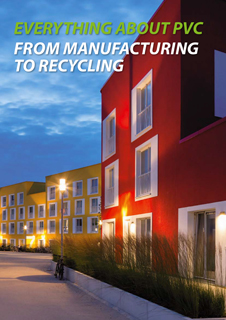Sustainable Development
PVC products perform well ecologically as well as socially and economically. Essential for this success are low life-cycle costs, longevity, and the recyclability of these high-quality products.
Evaluation of Sustainability
Sustainable development must be evaluated from ecological, economic, and social perspectives. Assessments of individual areas can be misleading. AGPU has held extensive dialogues with experts from the economic sector, the sciences, environmental associations, as well as with journalists about PVC. One result of this process is the independent PROGNOS Study from 1999/2000 on the sustainability of selected PVC products and their alternatives: it was the first study that dealt with the concept of „sustainable development“ for individual products. The result was a balanced picture of PVC products with good results, but also with open questions and the possibility for improvements, which has led the way to a sustainable future for PVC.
Current information on the topic is summarised briefly below. In doing so, ecological observations are based on LCAs and risk assessments, for the entire life cycle of products of course.
Ecological Factors
Part of the ecological quality of products and services can be determined by life-cycle observations. Risk assessments round off the ecological quality. In order to evaluate sustainable development reliably, social and economic factors must also be taken into consideration. The European plastics industry is compiling essential life-cycle data (eco-profiles) on a standardised basis for the manufacturing and processing of important plastic materials and continuously updates this information. Qualified institutions compile LCAs for products based on these eco-profiles. In the process, additional information is taken into consideration, such as the local electrical power situation, recycling, waste disposal, etc. An important study which focuses on PVC products was conducted by H. Krähling.
Perhaps the most extensive study on the life cycle assessments of PVC products was commissioned by the European Union in 2004 under the direction of PE Europe GmbH – Life Cycle Engineering. It shows that PVC products are very comparable to other products made from different materials in terms of life cycle assessment. However, for the reliable life cycle assessment of specific products one must still consider
- that it sometimes may be necessary to have varying amounts of materials for similar products made of different materials; and
- that processing, recycling, and recovery, etc. must be assessed. In doing so, life cycle assessments should correspond to ISO 14040/44.
The resource and energy efficiency of PVC products often proves to be especially advantageous for life cycle assessments. Recycling and material-saving designs provide additional possibilities for improvement. Careful planning and building in the construction sector in particular, especially (energy-efficient) savings in terms of use and low expenditures for care and maintenance, are far more important than the materials applied. This opinion is shared by the Federal Ministry of Building which developed the guidelines for sustainable government buildings.
On the basis of life cycle assessment data, more easily readable evaluations are also compiled such as EPDs (Environmental Product Declarations). They summarize the numerous results of life cycle assessments through various ecological criteria such as energy consumption, climate effects, or acidification.
Ecological profile data as well as EPDs for individual plastic materials is available on the website of PlasticsEurope. It is considered the most reliable quantitative data for plastic materials worldwide. In comparing this data to the corresponding data of other materials, it must be taken into consideration that the methods of compiling the ecological profile data always vary to some extent. Therefore, exact comparisons are not possible.
Economic Factors
PVC products are distinguished by their longevity, low costs for maintenance, and recyclability. Their life-cycle costs are correspondingly low: this is a fact that has direct influence on their market success. Consumers choose the more cost-effective product with the same performance. They know that economic resources are limited, just like all other resources, and try to use them carefully for optimal benefits.
However, low life-cycle costs are also tied to ecological and social factors in qualitative and quantitative terms. These savings can therefore also be used for ecological and social objectives. We see two possibilities in assessing costs and ecology simultaneously in quantitative terms:
One possibility is to present the costs in addition to ecological results such as in the eco-efficiency model at BASF. In this example, ecological results are combined into one unit by standardisation and importance and compared to the standardised costs. Another possibility is the direct combination of the two criteria, which means a “compensatory” method. In doing so, possible cost advantages between alternative products are used to finance ecological improvements, such as steps for saving energy or preventing climate effects. For example, a specific calculation is available for PVC windows and alternatives. By using approximately 1% of the product costs for a PVC window, 100% of the climate effect generated through this product can be compensated:22 this is a small financial expenditure with great effect. This „compensatory“ method has been used for years for „climate-neutral flights“.
Low life-cycle costs also have a positive effect on the social sector: for example, the poor and many nations in the Third World are now more likely to be able to afford low-priced products e.g. in health and education.
On the other hand, the refusal of some communities to use PVC means „more costs without any quantifiable ecological advantages“. The additional costs resulting from the refusal can in fact be calculated and no longer invested in sensible ecological and social gains. PVC substitution without economic and ecological basis can even lead to a deterioration of the present situation, as determined by Enquête Commission25 and the German Federal Environment Agency (UBA).
Social Factors
For decades, PVC products have stood the test of time in almost all areas of our daily lives. In the process, they have been extensively researched and continuously developed in order to offer high safety and quality standards: this extends from the selection of raw materials and improved formulations to state of the art manufacturing methods. The wide range of products satisfy demanding requirements for modern, future-oriented solutions: in health care, building technology, as well as everyday goods in the home and at work.
Many products are essential for the functioning of our complex daily lives and are distinguished by their tremendous social benefits. Wires and cables with sheathings or insulation made of soft PVC ensure a smooth data transfer and reliably supply us with energy. Disposable gloves meet high hygienic standards in medical care. The same holds true for easy sterilisable blood bags and tube systems for nutritional care. Pipes for drinking water provide permanent access to clean water without giving bacteria a chance to survive. Modern plastic windows provide pleasant indoor climate conditions and save energy. Safety products such as welding curtains and reflectors for work clothes increase safety at the workplace. In all these areas, this high performance plastic has proven to be a safe and reliable partner.
In the process, economic PVC products have a positive effect on society. Cost-effective, high-quality products are available to a number of people and affordable to lower-income people who thus have the pleasure of enjoying a higher standard of living. Savings from buying reasonably-priced products, on the other hand, can be used to help promote further ecologicaland social improvements; this is an effective contribution to sustainable development. In addition, optimising manufacturing and processing methods guarantees good working conditions, which are also reflected in job safety and a low accident rate.
Everyting about PVC"
The brochure „Everything about PVC – from production to recycling“ was revised in January 2016 and contains up-to-date data on all relevant topics concerning PVC. You can download the English version as PDF here.

